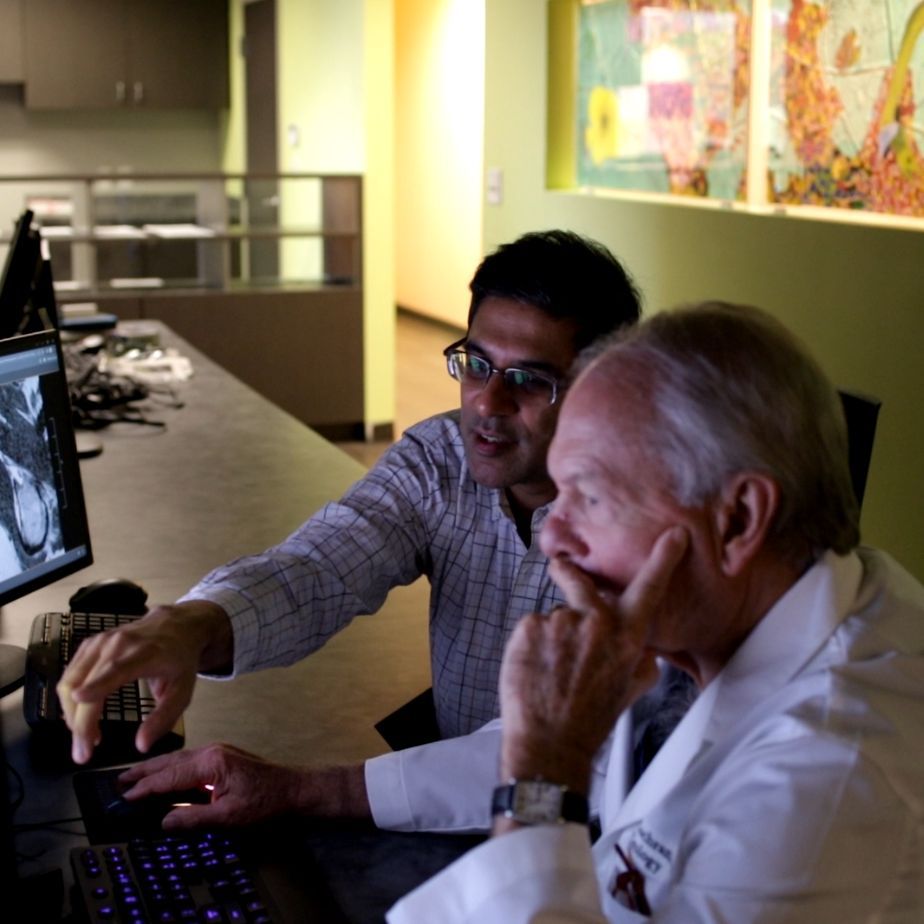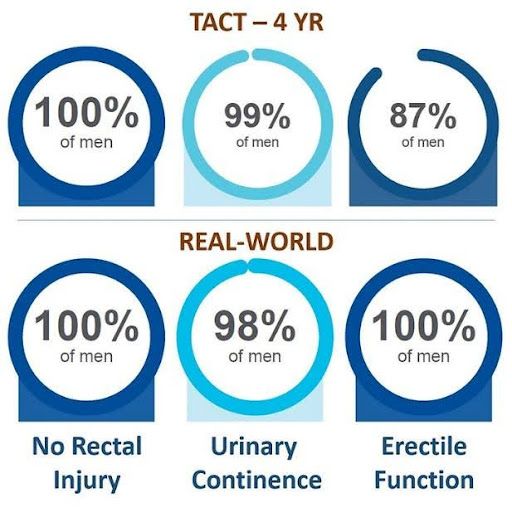The Latest and Most Precise FDA-Cleared Treatment for Localized Prostate Cancer and Enlarged Prostate!
The name ‘TULSA’ stands for Transurethral Ultrasound Ablation. The TULSA Procedure is incisionless, radiation-free, and FDA cleared. It is an image-guided procedure that uses directional ultrasound to produce high temperatures in the prostate gland to ablate (destroy) targeted tissue. The procedure combines real-time MRI with robotically driven directional thermal ultrasound to deliver physician prescribed focal or whole gland ablation. This enables the procedure to be customized depending on your needs, conditions, and desired functional outcomes.
The entire procedure is performed while you are asleep inside a Magnetic Resonance Imager (MRI), enabling us to see your cancer, the prostate gland, and surrounding tissue throughout the treatment. This integration of real-time MRI into treatment is unique compared to all other methods of prostate treatment, and gives TULSA Pro a precision of 1 mm, better than any other treatment modality on the market.
A very important point regarding the TULSA Procedure is that it does NOT limit future treatment options (surgery, radiation, repeat TULSA), nor does it increase the complication rates of these procedures. As a result, it is quickly becoming a first-line treatment of choice for men with localized disease, who want to eradicate their cancer without risking urinary, sexual or bowel complications. The TULSA procedure is also one of the best options local recurrences of cancer within the prostate after primary radiation therapy.
Watch the video to learn more about the TULSA procedure and clinical outcomes.

The TULSA Procedure was invented by Dr. Chopra, one of the founders of Texas Prostate. He founded Profound Medical in 2008, when the power of using MRI to diagnose prostate cancer was only starting to be recognized, but doing treatments inside an MRI was unheard of. Through his persistence over the intervening 15 years, TULSA was advanced through animal and human trials, and received FDA Clearance for prostate tissue ablation in 2019 after the completion of the TACT trial. Since then, over 3000 men have undergone the TULSA procedure globally with remarkable outcomes. The TULSA Procedure is poised to become the standard of care for men with localized prostate cancer, and Dr. Chopra has partnered with Dr. Cochran to make it available to the men of North Texas and beyond.
The TULSA Procedure is performed inside a clinical MRI while you are under general anesthesia. A transurethral ultrasound applicator (UA) is located in your prostate gland. Then we take pictures of your prostate and outline the region of your gland to be treated. As the UA delivers ultrasound to heat this region, the MRI continuously takes pictures of the prostate gland. These images are sent immediately to the TULSA-PRO system, where they are converted into temperature images and analyzed by the software. Based on the heating in the prostate, the TULSA-PRO system makes fine adjustments to the device output to shape the heating to the targeted region for ablation. This process of taking pictures, analyzing, and adjusting, happens throughout the procedure, and is what makes the ablation so precise. It is referred to as closed-loop control. The video depicts the procedure and the temperature information that is obtained throughout the gland during treatment.
The objective way to answer this is with long-term clinical data. Men who were treated with TULSA in the 2019 TACT trial have now been followed up for 5 years. Approximately 20% of men who had a whole-gland single TULSA treatment have required additional intervention after 5 years (left graph). Comparing this to the standard-of-care surgical treatment for prostate cancer (see graph), the results from multiple large clinical trials show virtually an identical outcome over time. This shows that the 5-year cancer control outcomes of TULSA match those of surgery.
1. Customizable Treatment Plan
The flexibility of the TULSA Procedure lets you design a treatment plan that is personalized based on your unique prostate anatomy, and your quality-of-life goals. This type of patient-specific customization is unique to the TULSA Procedure.
2. Same Day Out-Patient Procedure
The TULSA Procedure is a one-and-done procedure, performed in a single session that takes a few hours. There is no need for repeat visits, meaning you can take less time off work, spend less time in recovery, and spend more time living.
3. Precise Ablation
The TULSA Procedure is extremely precise, which allows for local control of clinically significant disease, with significant PSA reduction and low rates of residual cancer on follow-up biopsy.
4. Low Complications
Based on 5-year clinical outcomes, the TULSA Procedure has a very low risk of everyday functional decline because important nerve bundles and structures around your prostate can be safely avoided.
5. Rapid Recovery Time
Most patients experience minimal to no pain after treatment and return to activities in a few days. For most men, their erectile and urinary functions return to baseline in about 3 months.
6. Keep Future Options Open
If you are in need of future prostate care, you may either have a repeat TULSA Procedure, or choose any other type of treatment to address your prostate needs.
Any medical procedure has risks. Because the TULSA Procedure is performed while you are asleep, it has the usual risks associated with general anesthesia. We screen all men to ensure they can undergo anesthesia safely before recommending the TULSA Procedure.
With respect to prostate complications, we refer back to long-term clinical outcomes. Real-world clinical outcomes from the Alta clinic in Germany are shown below. TULSA does not impact rectal or urinary function. The treatment can be customized to avoid neurovascular bundles so erectile function is preserved.
Any way the data is sliced, there is no other treatment modality that offers this side effect profile. You may think this is too good to be true. Come talk to us so we can show you.


The most likely reason is that they don’t know about TULSA Pro, or consider it an experimental treatment. They are likely unaware there are solid and indisputable 5-year clinical outcomes that show otherwise. Urologists and radiation oncologists know what they know (surgery and radiation). They have invested billions of dollars into advances in their domains, such as the surgical robot, or proton therapy, but time has shown these approaches cost more with minimal benefit in the areas men care about. Men want and deserve better treatments that manage their cancer without having to sacrifice their quality of life. TULSA Pro is that answer and we encourage you to contact Texas Prostate to learn more.
The TULSA Procedure is a same-day outpatient procedure. Following a TULSA Procedure, the patient is discharged from the clinic the same day, once they are recovered from the general anesthetic.
The TULSA Procedure is performed in a single session, and the time of the procedure depends on the treatment plan that’s prescribed (whole vs partial gland treatment). In general the procedure is between 2 and 4 hours.
Yes, there are close to 100 peer-reviewed papers and research on the TULSA Procedure that can be found online. You can read some of the key clinical publications regarding the TULSA Procedure and prostate health here.
Unfortunately, the procedure is not yet covered by Medicare or major Insurers, and it is paid as an out-of-pocket procedure. We offer the treatment in a concierge medical environment that matches your investment. Approximately half of our patients that have sought coverage from their insurance provider have received some form of reimbursement through appeals.
Prostate Cancer: Generally, the procedure is well suited for cancer that is only within the prostate gland, and is in the low- to intermediate- risk category. It is also suitable for men with a recurrence in their gland after radiation therapy.
Enlarged Prostate: Most men with enlarged prostate (BPH) will experience relief after the TULSA Procedure because the gland will shrink over time.
There are additional criteria that can qualify or disqualify you for the procedure. Contact us so we can help you determine your eligibility